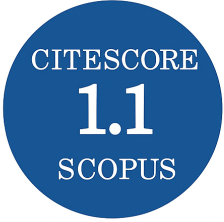Wearable Systems and Methods for Monitoring Psychological and Physical Condition of Soldiers
DOI:
https://doi.org/10.3849/aimt.01186Keywords:
physical state, psychological state, monitoring, army, health condition, wearable systemsAbstract
From the second half of the 1990s, thanks to more affordable and more powerful information technology and electronical systems for recording based on miniaturized sensors, we can observe a more intensive development of a method of data analysis and a system
that monitors the physical and psychological conditions of soldiers. Systems for measuring and evaluation methods of physical and medical data for the diagnostics of physical and psychological state have significantly spread, especially in clinical practice. This study,
however, examines the current technologies and usage of the wearable monitoring systems in military field. The result of this study is not only the not‐yet published summary of the current state, but also the proposed possibilities of usage and recommendation of specific systems, their sensors and system methods in the military. Thus, the article can serve as a guide for choosing suitable and affordable electronical wearable systems and methods of quantitative evaluation of physical and psychological conditions of people in the military.
References
SHNAYDER, V., CHEN, B., LORINCZ, K., FULFORD‐JONES, T. and WELSH, M. Sensor Networks for Medical Care. In Harvard University Technical Report TR-08-05. Cambridge: Harvard University, 2005.
SHELTAMI, T., MAHMOUD, A. and ABU‐AMARA, M. Warning and Monitoring Medical System Using Sensor Networks. In Proceedings of the Saudi 18th National Computer Conference (NCC18), 2006, p. 26-29.
Continuous Mobile Services for Healthcare [on line]. [cited 2017-01-04]. Available from: <http://www.healthservice24.com>.
GAO, T. et al. The Advanced Health and Disaster Aid Network: A Light‐weight Wireless Medical System for Triage. IEEE Transactions on Biomedical Circuits and Systems, 2007, vol. 1, no. 3, p. 203-216. DOI 10.1109/TBCAS.2007.910901.
JANTUNEN, I. et al. Smart Sensor Architecture for Mobile‐terminal‐centric Ambient Intelligence. Sensors and Actuators A: Physical, 2008, vol. 142, no. 1, p. 352-360. https://doi.org/10.1016/j.sna.2007.04.014.
WAC, K. et al. Mobile Patient Monitoring: the MobiHealth System. In Engineering in Medicine and Biology Society, 2009. EMBC 2009. Annual International Conference of the IEEE. IEEE, 2009, p. 1238-1241. https://doi.org/10.1109/IEMBS.2009.5333477.
FARELLA, E. et al. Interfacing Human and Computer with Wireless Body Area Sensor Networks: the WiMoCA Solution. Multimedia Tools and Applications, 2008, vol. 38, no. 3, p. 337-363. https://doi.org/10.1007/s11042-007-0189-5.
JIANG, S. et al. CareNet: An Integrated Wireless Sensor Networking Environment for Remote Healthcare. In Proceedings of the ICST 3rd International Conference on Body Area Networks. Institute for Computer Sciences, Social‐Informatics and Telecommunications Engineering, 2008, p. 9. ISBN 978-963-9799-17-2.
CURTIS, D. et al. Physiological Signal Monitoring in the Waiting Areas of an Emergency Room. In Proceedings of the ICST 3rd International Conference on Body Area Networks. ICST, 2008, p. 5. ISBN 978-963-9799-17-2.
Wear‐a‐BAN — Unobtrusive Wearable Human to Machine Wireless Interface [on line]. [cited 2017-01-04]. Available from <http://www.wearaban.com>.
Help4Mood [on line]. [cited 2017-01-04]. Available from: <http://www.help4mood.info>.
WearIT@work Project [on line]. [cited 2017-01-04]. Available from: <http://www.wearitatwork.com>.
SCHLENKER, J. et al. FlexiGuard: Modular Biotelemetry System for Military Applications. In 2015 International Conference on Military Technologies. Brno: IEEE, 2015, p. 1-6. https://doi.org/10.1109/MILTECHS.2015.7153712.
CORMORAN Project Exploring Ways to Improve Cooperation In and between Wireless Body Area Networks [on line]. Communications of the ACM. [cited 2017-04-01]. Available from: <http://cacm.acm.org/news/165000-cormoranproject-exploring-ways-to-improve-cooperation-in-and-between-wireless-bodyarea-networks/fulltext>.
CURONE, D. et al. Smart Garments for Emergency Operators: the ProeTEX Project. IEEE Transactions on Information Technology in Biomedicine, 2010, vol. 14, no. 3, p. 694-701. https://doi.org/10.1109/TITB.2010.2045003.
HALL, P.S. et al. Antennas and Propagation for Body‐Centric Wireless Network. 2nd edition. P.S. Hall, Y. Hao (editors), Boston: Artech Hosue, 2012, p. 586-589.
AKYILDIZ, I.F. et al. A Survey on Sensor Networks. IEEE Communications magazine, 2002, vol. 40, no. 8, p. 102-114. https://doi.org/10.1109/MCOM.2002.1024422.
LIM, HB. et al. A Soldier Health Monitoring System for Military Applications. In Body Sensor Networks (BSN), 2010 International Conference on Body Sensor Networks. IEEE, 2010, p. 246-249. https://doi.org/10.1109/BSN.2010.58.
JAISWAR, D. and REPAL, S.S. Real Time Tracking and Health Monitoring of Soldiers using ZigBee Technology: A Survey. International Journal of Innovative Research in Science, Engineering and Technology, 2015, vol. 4, no. 7. https://doi.org/10.15680/IJIRSET.2015.0407100.
NIKAM, S. et al. GPS Based Soldier Tracking and Health Indication System. International Journal of Advanced Research in Electrical, Electronics and Instrumentation Engineering, 2013, vol. 2, no. 3. ISSN 2320-3765.
PRAMOD, P. GPS Based Advanced Soldier Tracking with Emergency Messages & Communication System. International Journal of Advance Research in Computer Science and Management Studies Research Article, 2014, vol. 2, no. 6. ISSN 2091-2730.
JAVAID, N. et al. Measuring fatigue of soldiers in wireless body area sensor networks. In Broadband and Wireless Computing, Communication and Applications (BWCCA), 2013 Eighth International Conference on. IEEE, 2013. p. 227-231. https://doi.org/10.1109/BWCCA.2013.43.
KIM, Y.S. et al. Helmet‐based Physiological Signal Monitoring System. European Journal of Applied Physiology, 2009. vol. 105, no. 3, p. 365-372. https://doi.org/10.1007/s00421-008-0912-6.
KIM, Y.S. et al. ECG, EOG Detection from Helmet Based System. In Information Technology Applications in Biomedicine, 2007. 6th International Special Topic Conference on Information Technology Applications in Biomedicine. IEEE, 2007, p. 191-193. https://doi.org/ 10.1109/ITAB.2007.4407378.
PRAKASH, P. and ADINARAYANA, T.V.S. A Novel Approach of Sensors‐Based Wearable Systems for Monitoring of Human Movement and Falls. International Journal of Science and Research (IJSR), 2014. vol. 3, no. 7. ISSN 2319-7064.
PANTELOPOULOS, A. and BOURBAKIS, NG. A Survey on Wearable Sensorbased Systems for Health Monitoring and Prognosis. IEEE Transactions on Systems, Man, and Cybernetics, Part C (Applications and Reviews), 2010, vol. 40, no. 1, p.1-12. https://doi.org/10.1109/TSMCC.2009.2032660.
LLORET, J. Introduction to Practical Deployments on Wireless Sensor Networks. International Journal on Advances in Networks and Services, 2010. vol. 3, no. 1 & 2.
DARWISH, A. and HASSANIEN, A.E. Wearable and Implantable Wireless Sensor Network Solutions for Healthcare Monitoring. Sensors, 2011. vol. 11, no. 6, p. 5561-5595. https://doi.org/10.3390/s110605561.
BRANCHE, P.C. et al. Measurement Reproducibility and Sensor Placement Considerations in Designing a Wearable Pulse Oximeter for Military Applications. In Bioengineering Conference, 2004. Proceedings of the IEEE 30th Annual Northeast. IEEE, 2004. p. 216-217. https://doi.org/10.1109/NEBC.2004.1300072.
MENDELSON, Y., DUCKWORTH, R.J. and COMTOIS, G. A Wearable Reflectance Pulse Oximeter for Remote Physiological Monitoring. In Engineering in Medicine and Biology Society, 2006. EMBS'06. 28th Annual International Conference of the IEEE. IEEE, 2006, p. 912-915.
https://doi.org/10.1109/IEMBS.2006.260137.
TAMURA, T. et al. Wearable Photoplethysmographic Sensors – Past and Present. Electronics, 2014, vol. 3, no. 2, p. 282-302.
https://doi.org/10.3390/electronics3020282.
BERA, T.K. Bioelectrical Impedance Methods for Noninvasive Health Monitoring: A Review. Journal of Medical Engineering, 2014.
https://doi.org/10.1155/2014/381251.
SHAW, G.A. et al. Warfighter Physiological and Environmental Monitoring: A Study for the US Army Research Institute in Environmental Medicine and the Soldier Systems Center [Final Report]. Massachusetts Institute of Technology Lincoln Laboratory, 2004.
KALE, S.D. and BHUYAR, D.L. A Review on WBANs Measuring Fatigue of Soldiers and Different Protocols. International Journal of Advanced Research in Electrical, Electronics and Instrumentation Engineering, 2016, vol. 5, no. 3. https://doi.org/10.15662/IJAREEIE.2016.0503035.
PERALA, C.H. and STERLING, B.S. Galvanic Skin Response as a Measure of Soldier Stress. Army Research Lab Aberdeen Proving Ground Md Human Research and Engineering Directorate, 2007.
SOLOVEI, D. et al. The Development of Portable System for Unobtrusive Perspiration Monitoring. Procedia Engineering, 2012, vol. 47, p. 200-203. https://doi.org/10.1016/j.proeng.2012.09.118.
SOLOVEI, D. et al. Chemical Sensor Platform for non‐invasive monitoring of activity and dehydration. Sensors, 2015. vol. 15, no. 1, p. 1479-1495. https://doi.org/10.3390/s150101479.
VASHIST, S.K. Non‐invasive Glucose Monitoring Technology in Diabetes Management: A Review. Analytica Chimica Acta, 2012, vol. 750, p. 16-27. https://doi.org/10.1016/j.aca.2012.03.043.
SAGAHYROON, A. et al. Monitoring Patients’ Signs Wirelessly. Journal of Medical Imaging and Health Informatics, 2011, vol. 1, no. 3, p. 252-255. https://doi.org/10.1109/MECBME.2011.5752121.
KIM, J. et al. Non‐invasive Mouthguard Biosensor for Continuous Salivary Monitoring of Metabolites. Analyst, 2014, vol. 139, no. 7, p. 1632-1636. https://doi.org/10.1039/c3an02359a.
THOMAS, N., LÄHDESMÄKI, I. and PARVIZ, B.A. A Contact Lens with an Integrated Lactate Sensor. Sensors and Actuators B: Chemical, 2012, vol. 162 no. 1, p. 128-134. https://doi.org/10.1016/j.snb.2011.12.049.
KHODAGHOLY, D. et al. Organic Electrochemical Transistor Incorporating an Ionogel as a Solid State Electrolyte for Lactate Sensing. Journal of Materials Chemistry, 2012, vol. 22, no. 10, p. 4440-4443. https://doi.org/10.1039/C2JM15716K.
IGUCHI, S. et al. A Flexible and Wearable Biosensor for Tear Glucose Measurement. Biomedical Microdevices, 2007, vol. 9, no. 4, p. 603-609. https://doi.org/10.1007/s10544-007-9073-3.
WINDMILLER, J.R. et al. Stamp Transfer Electrodes for Electrochemical Sensing on Non‐planar and Oversized Surfaces. Analyst, 2012, vol. 137, no. 7, p. 1570-1575. https://doi.org/10.1039/c2an35041f.
GUINOVART, T. et al. A Potentiometric Tattoo Sensor for Monitoring Ammonium in Sweat. Analyst, 2013, vol. 138 no. 22, p. 7031-7038. https://doi.org/10.1039/c3an01672b.
BANDODKAR, A.J. et al. Epidermal Tattoo Potentiometric Sodium Sensors with Wireless Signal Transduction for Continuous Non‐invasive Sweat Monitoring. Biosensors and Bioelectronics, 2014, vol. 54, p. 603‐609. https://doi.org/10.1016/j.bios.2013.11.039.
BULLER, M.J. et al. Real‐time Core Body Temperature Estimation from Heart Rate for First Responders Wearing Different Levels of Personal Protective Equipment. Ergonomics, 2015, vol. 58, no.11, p. 1830-1841. https://doi.org/10.1080/00140139.2015.1036792.
KEARNS, W.D., et al. Tortuosity in Movement Paths is Related to Cognitive Impairment. Methods Inf. Med, 2010, vol. 49, no. 6, p. 592-598. https://doi.org/10.3414/ME09-01-0079.
QUATIERI, T.F. and MALYSKA, N. Vocal‐source Biomarkers for Depression: A Link to Psychomotor Activity. Interspeech [on line]. 2012, p. 1059-1062. [cited 2016-10-05]. Available from: < https://www.ll.mit.edu/mission/cybersec/publications/publication-files/
full_papers/2012_09_09_MalyskaN_Interspeech_FP.pdf>.
CLEMENTS, C.M. et al. Loaded and Unloaded Foot Movement Differentiation Using Chest Mounted Accelerometer Signatures. In Body Sensor Networks (BSN), 2013 IEEE International Conference on. IEEE, 2013. p. 1-5. https://doi.org/10.1109/BSN.2013.6575524.
FRIEDL, K.E. et al. Real Time Physiological Status Monitoring (RT‐PSM): Accomplishments,Requirements, and Research Roadmap [on line], 2016. Army Research Inst. of Environmental Medicine Natick MA Biophysics and Biomedical Modeling div. [cited 2016-10-08]. Available from: <http://www.dtic.mil/cgibin/GetTRDoc?AD=ADA630142>.
QU, X. and YEO, J. Effects of Load Carriage and Fatigue on Gait Characteristics. Journal of biomechanics, 2011, vol. 44, no. 7, p. 1259-1263. https://doi.org/10.1016/j.jbiomech.2011.02.016.
CHU, Y. et al. Minimal Additional Weight of Combat Equipment Alters Air Assault Soldiers’ Landing Biomechanics. Military Medicine, 2010, vol. 175, no. 1, 41 p.
HAO, Y. and FOSTER, R. Wireless Body Sensor Networks for Health‐monitoring Applications. Physiological Measurement, 2008, vol. 29, no. 11, 27 p. https://doi.org/10.1088/0967-3334/29/11/R01.
HESS, C.W. and PULLMAN, S.L. Tremor: Clinical Phenomenology and Assessment Techniques. Tremor and other Hyperkinetic Movements, 2012. https://doi.org/10.7916/D8WM1C41.
XU, H., et al. Wearable Sensor‐Based Human Activity Recognition Method with Multi‐Features Extracted from Hilbert‐Huang Transform. Sensors, 2016, vol. 16, no. 12, 2048 p. https://doi.org/10.3390/s16122048.
NAJARIAN, K. et al. Method and Apparatus for Determining Heart Rate Variability Using Wavelet Transformation. U.S. Patent Application No 13/140,165, 2009.
SCHIFFMAN, J.M. et al. Nonlinear Analysis of Gait Kinematics to Track Changes in Oxygen Consumption in Prolonged Load Carriage Walking: A Pilot Study. Journal of Biomechanics, 2009. vol. 42, no. 13, p. 2196-2199. https://doi.org/10.1016/j.jbiomech.2009.06.011.
MEIJER, R. et al. Markedly Impaired Bilateral Coordination of Gait in Poststroke Patients: Is this Deficit Distinct from Asymmetry? A Cohort Study. Journal of Neuroengineering and Rehabilitation, 2011, vol. 8, no. 1, 23 p. https://doi.org/10.1186/1743-0003-8-23.
PARAK, J., DVORAK, J. and HAVLIK, J. Device for Long Term Measurement of Heart Rate. In Proceedings of the 4th International Symposium on Applied Sciences in Biomedical and Communication Technologies. ACM, 2011, p. 19.
STORK, M. and TOLAR, D. Wireless Electronic Systems for Physiological Parameters Measuring. In Applied Electronics (AE), 2014 International Conference on. IEEE, 2014. p. 281-284.
TOLAR, D. et al. Wireless System for Monitoring Body Temperature. In 7th WACBE World Congress on Bioengineering 2015. Springer, 2015, p. 150-153.
HON, Z. et al. A Surveillance System for Enhancing the Safety of Rescue Teams, Komunikácie, 2015, vol. 17, no. 1, p. 81-86.
ROSEN, J. and PERRY, J.C. Upper Limb Powered Exoskeleton. International Journal of Humanoid Robotics, 2007, vol. 4, no. 3, p. 529-548.
SAQUIST, T.F. Remote Physiological Health and Status Monitoring of First Responders: Promises, Practicalities, and Prospects. Sanquist: U.S. Department of Energy, Pacific Northwest National Laboratory, 46 p. [on line]. [cited 2016-10-07]. Available from: <http://nwrtc.pnnl.gov/PDFs/RemotePhysiologicalHealthandStatusMonitoringofFirstRespondersR13.pdf>.
Downloads
Published
License
Copyright (c) 2017 Advances in Military Technology

This work is licensed under a Creative Commons Attribution-NonCommercial 4.0 International License.
Authors who publish with this journal agree to the following terms:
1. Authors retain copyright and grant the journal right of first publication with the work simultaneously licensed under a Creative Commons Attribution License that allows others to share the work with an acknowledgement of the work's authorship and initial publication in this journal.
2. Authors are able to enter into separate, additional contractual arrangements for the non-exclusive distribution of the journal's published version of the work (e.g., post it to an institutional repository or publish it in a book), with an acknowledgement of its initial publication in this journal.
3. Authors are permitted and encouraged to post their work online (e.g., in institutional repositories or on their website) prior to and during the submission process, as it can lead to productive exchanges, as well as earlier and greater citation of published work.
Users can use, reuse and build upon the material published in the journal for any purpose, even commercially.






